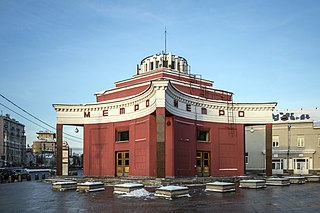
The Moscow Metro is a metro system serving the Russian capital of Moscow as well as the neighbouring cities of Krasnogorsk, Reutov, Lyubertsy and Kotelniki in Moscow Oblast. Opened in 1935 with one 11-kilometre (6.8 mi) line and 13 stations, it was the first underground railway system in the Soviet Union.
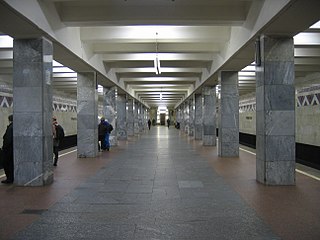
Tushinskaya is a station on the Tagansko-Krasnopresnenskaya Line of the Moscow Metro. It was designed by I.G. Petukhova and V.P. Kachurinets and opened on 30 December 1975. The station was built to a modified standard design, with grey-blue marble pillars and white marble walls with inlaid zigzag friezes. Tushinskaya is one of the Metro's busiest stations, serving about 111,000 passengers per day according to a 1999 study.
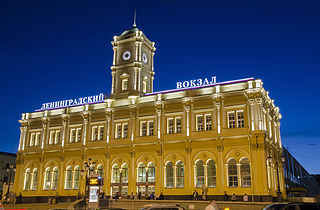
Moscow Leningradsky railway terminal also known as Moscow Passazhirskaya station is the oldest of Moscow's nine railway terminals. Situated on Komsomolskaya Square, the station serves north-western directions, notably Saint Petersburg. International services from the station include Tallinn, Estonia, operated by GoRail, and Helsinki, Finland.

Vykhino is a station on Moscow Metro's Tagansko-Krasnopresnenskaya line. Opened on 31 December 1966 as the final part of the Zhdanovsky Radius, the station was the southeastern terminus of the line until 9 November 2013, when the extension to Lermontovsky Prospekt and Zhulebino was opened. The metro station is part of a multi-modal transfer hub, which also consists of the mainline suburban railway.
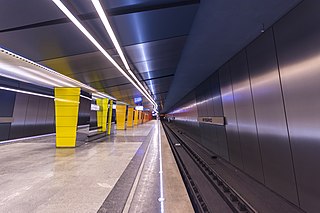
Zhulebino is a station on Moscow Metro's Tagansko-Krasnopresnenskaya Line. It is named after Zhulebino district and situated at the intersection of General Kuznetsov and Aircraft designer Mil streets. Zhulebino was opened on 9 November 2013. The construction lasted for two years. The station was to be opened on 6 November 2013, however due to a technical failure of a train at neighbouring Lermontovsky Prospekt station it was delayed until the 9th. Its location is outside the Moscow Ring Road beltway.

Varshavsky station, or Warsaw station, is a former passenger railway station in Saint Petersburg, Russia. It is located to the south of the city centre, and was in operation from 1853 to 2001 From 2001 to 2017 it served as the home of the Russian Railway Museum.
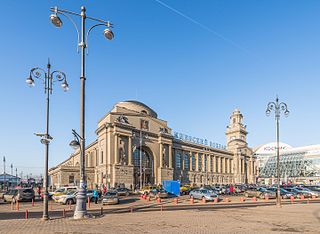
Kiyevsky railway terminal also known as Moscow Kiyevskaya railway station is one of the nine railway terminals of Moscow, Russia. It is the only railway station in Moscow to have a frontage on the Moskva River. The station is located at the Eurasia Square, in the beginning of Bolshaya Dorogomilovskaya Street in Dorogomilovo District of Moscow. A hub of the Moscow Metro is located nearby.

Kursky railway terminal, also known as Moscow Kurskaya railway station, is one of the ten railway terminals in Moscow. It was built in 1896, and renovated in 1938, then a large glass facade and modern roof was added in a 1972 expansion. In 2008, there were plans to completely rebuild or refurbish the station. Kursky station, unlike most Moscow terminals, operates two almost opposite railroad directions from Moscow: one toward Kursk, Russia, after which the station is named, that stretches on into Ukraine, and another toward Nizhniy Novgorod, which is less used by long-distance trains, and is mostly for the high-speed service to Nizhniy. Kursky is connected to the Lengradskiy Line from the other side, enabling long-distance trains from St. Petersburg going on to other cities to pass through Russia's capital. Because of its three directions, its adjacency to the city center, and its connection to three major metro lines, Kursky is one of Moscow's busiest railway stations.

Kazansky railway terminal also known as Moscow Kazansky railway station is one of nine railway terminals in Moscow, situated on the Komsomolskaya Square, across the square from the Leningradsky and Yaroslavsky stations. It was ranked nr. 9 in a list of Europe's best train stations by the Consumer Choice Centre in 2020.

Belorussky railway station also referred to as Moscow–Passenger–Smolenskaya, Informally the whole station can be called as Moscow Belorusskaya, is a railway terminal of the Moscow Railway located at the front of Tverskaya Zastava Square in Central Administrative Okrug, Moscow. The station is one of nine railway terminals of Moscow. It was opened in 1870 and rebuilt in its current form in 1907–1912.

Moscow Yaroslavsky railway station is one of the nine main railway stations in Moscow. Situated on Komsomolskaya Square, Moscow Yaroslavskaya has the highest passenger throughput of all nine of the capital's main-line terminuses. It serves eastern destinations, including those in the Russian Far East, being the western terminus of the world's longest railway line, the Trans-Siberian. The station takes its name from that of the ancient city of Yaroslavl which, lying 284 rail kilometres north-east of Moscow, is the first large city served by the line.

Rizhsky station is one of the ten main railway stations in Moscow, Russia. It was built in 1901. As well as being an active station it also houses the Moscow Railway Museum. The station is operated by the Moscow Railway.
The Little Ring of the Moscow Railways, is a 54.4-kilometre-long (33.8 mi) orbital railway in Moscow.

Lermontovsky Prospekt is a station on Moscow Metro's Tagansko-Krasnopresnenskaya line. It is located between Vykhino and Zhulebino and opened, together with Zhulebino, on 9 November 2013. The station is constructed below the intersection of Khvalynsky Boulevard and Lermontovsky Avenue, hence the name of the station, and is located outside the Moscow Ring Road, approximately 500 metres (1,600 ft) from Kosino railway station. The construction of Lermontovsky Prospekt and Zhulebino was needed to unload Vykhino, which by the time of construction was the most crowded station of Moscow Metro.
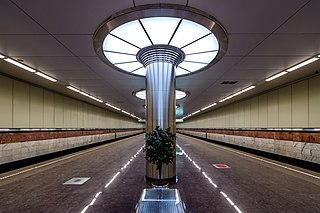
Kotelniki is a station on the Moscow Metro's Tagansko-Krasnopresnenskaya Line. The eastern terminus of the line, east of the station of Zhulebino, was opened on 21 September 2015. The station is located in the town of Kotelniki of Moscow Oblast. It is the second station of Moscow Metro in Moscow Oblast after Myakinino. In 1984, after the western part of the town of Lyubertsy was transferred to Moscow, rapid urban development started. The whole area, along with Lyubertsy and other areas along the Kazansky and Ryazansky suburban directions of Moscow Railway were strongly dependent on the station of Vykhino, then the terminus of the Tagansko-Krasnopresnenskaya Line and a transfer station to both railway directions. In the 2000s, Vykhino was heavily overloaded. Eventually, the decision was taken to extend the Tagansko-Krasnopresnenskaya Line beyond Vykhino. The construction of the first stretch, with the stations of Lermontovsky Prospekt and Zhulebino, was completed on 9 November 2013. The second stretch connected Zhulebino and Kotelniki.

Savyolovskaya is a station on the Bolshaya Koltsevaya line of the Moscow Metro. It opened on 30 December 2018. Until December 2020, this station also served as the terminus of Solntsevskaya line.

The Moscow Central Circle or MCC, designated Line 14 and marked in a strawberry red/white color is a 54-kilometre-long (34 mi) orbital urban/metropolitan rail line that encircles historical Moscow. The line is rebuilt from the Little Ring of the Moscow Railway, opened to passengers on 10 September 2016 and is operated by the Moscow Government owned company MKZD through the Moscow Metro, with the state-run Russian Railways selected as the operation subcontractor. The infrastructure, trackage and platforms are owned and managed by Russian Railways, while most station buildings are owned by MKZD.
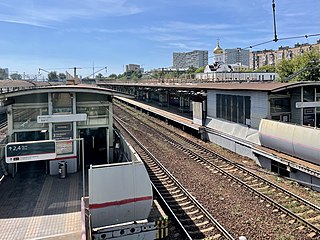
Losinoostrovskaya is a railway station located in Losinoostrovsky District of Moscow, Russia. The station serves suburban traffic of Yaroslavsky suburban railway line by Moscow Railway. The southbound trains terminate at Moscow Yaroslavskaya railway station in Moscow. The northbound trains terminate at the stations of Bolshevo, Fryazino Passazhirskaya, Monino, Shchyolkovo, Fryazevo, Pushkino, Sofrino, Krasnoarmeysk, Sergiyev Posad, Alexandrov I, and Balakirevo. All suburban trains stop at Losinoostrovskaya. The station is operated by the Moscow Railway.

D1 or Belorussko-Savyolovsky Diameter is the first of the Moscow Central Diameters, a suburban network in Moscow which uses the existing infrastructure of Moscow Railway and provides a regular connection between Moscow and surrounding cities. MCD-1 runs from Lobnya via Dolgoprudny and Moscow to Odintsovo.

D2 or Kursko-Rizhsky Diameter is the second of the Moscow Central Diameters, a suburban network in Moscow which uses the existing infrastructure of Moscow Railway and provides a regular connection between Moscow and surrounding cities. MCD-2 runs from Nakhabino via Krasnogorsk and Moscow to Podolsk.



















